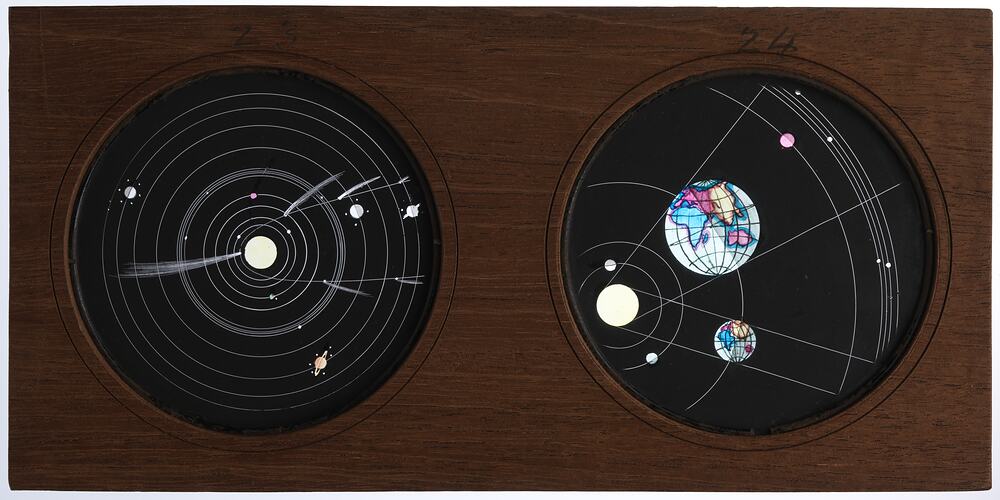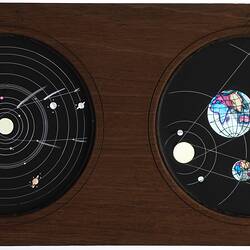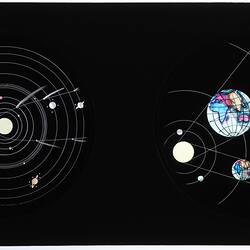Summary
This is a lantern slide consisting of two hand painted glass discs illustrating the Newtonian system of the planets, and an illustration of the Earth's shadow in space as it would be if the Earth were bigger than or the same size as the Sun, numbered '23' and '24' respectively. This lantern slide is part of a near-complete set of 19 slides used to illustrate a lantern lecture on astronomy, associated with the slide reading 'Popular Lecture on Astronomy'. This particular set was manufactured in England in approximately 1847, depicting astronomical knowledge about the planets as existed around that date. This set was used in Victoria in the nineteenth century. Precise details about its usage are unknown but equivalent sets were widely used in astronomical lantern lectures in Australia between the 1840s and 1880s, as can be seen from the synopses of lectures published in newspapers.
Lantern lectures were one of the most prominent and popular forms of entertainment in the nineteenth century. They were presented in a range of venues including schools, churches, Mechanics' Institutes and by itinerant lecturers, as well as occurring privately in domestic settings. Popular lectures on scientific subjects such as astronomy were a common theme for such performances and were specially associated with the philosophy of 'rational recreation' whereby people, especially the working classes, were encouraged to partake in improving pursuits in their spare time.
Description of Content
The slide consists of two astronomical diagrams. The diagram on the left glass disc, numbered 23 is of the Sun surrounded by the planets, asteroids, comets, and their orbits. It illustrates the Newtonian System of the Solar System, with bodies having elliptical orbits of varying eccentricities. The diagram on the right glass disc, numbered 24, shows the Earth in space. It demonstrates what the shape of the Earth's shadow would be if the Earth were larger than the Sun, or if it were the same size as the Sun.
Physical Description
A Multiple Slide consisting of two glass discs mounted in a solid wood frame. The glass discs are set in recessed holes and held in place by wire retaining springs. The glass discs are seated below the surface of the frame.
Significance
A number of different sets of astronomical lantern slides were produced in the nineteenth century. Sets with static paintings or simple motions were advertised as early as the 1820s.The first such sets appear to have been manufactured by W. & S. Jones. Later firms that produced such sets include Carpenter & Westley, F. West and E.M. Clarke. These sets continued to be sold throughout the nineteenth century. The rackwork astronomical sets that appeared from the 1840s onwards include some of the most technically sophisticated kinds of slides ever produced. While many individual lantern slides survive, complete, or near-complete sets that can be positively associated with a specific lecture reading are relatively rare. As such this set provides a valuable insight into the complete performance of an astronomical lantern lecture.
More Information
-
Collection Names
-
Collecting Areas
-
Acquisition Information
Donation from Bill Franzke, 2008
-
Place & Date Manufactured
England, 1846-1852
Dating of the slide set is based on the appearance of the planets and their moons in images numbers 13-16. Neptune (16) is shown with a ring. This 'discovery' was announced by William Lassell in 1846 so the images cannot be any earlier than this. The ring was retracted by Lassell in 1852 so the images are unlikely to be much later than that. Additionally Saturn (13, 14) is shown with seven moons; the discovery of an eighth moon was made in 1848. Thus the content of the images reflects astronomical knowledge as it was in 1846-1848, although it is possible that the manufacturer used outdated information making the date slightly later than 1848. Titles for individual slide images have been taken from the reading 'Popular Lecture on Astronomy' although it is noted that the version of the reading in the Bibliography tab is of a later date than this set of slides, as noted in the Bibliography module record Notes field. -
Format
Lantern Slide, Framed - Multiple Disc, Hand Coloured
-
Inscriptions
Handwritten in black ink above left image : '23' [designating sequential number 23 in a set of 38 images] Handwritten in black ink above right image: '24' [designating sequential number 24 in a set of 38 images]
-
Classification
-
Category
-
Discipline
-
Type of item
-
Dimensions
227 mm (Width), 10 mm (Depth), 110 mm (Height)
-
References
Butterworth, M., 'Astronomical Lantern Slides', The Magic Lantern Gazette, Vol. 19 (2) 2007, pp 3- 9. Gavine, D., 'Some early astronomical visual aids', Journal of the British Astronomical Association, Vol. 88, (1977), pp. 32 - 37
[Other] Popular Lecture on Astronomy.
-
Keywords


